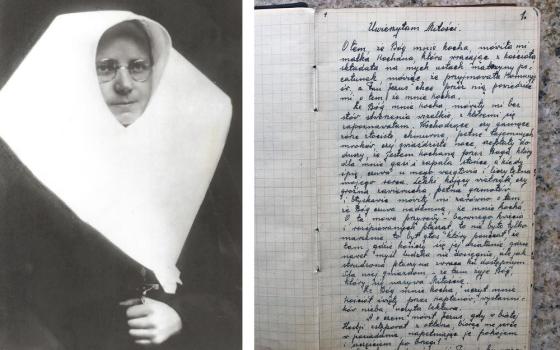Canonization still awaiting a miracle
ROME -- In the court of popular opinion, Mother Teresa – now Blessed Teresa of Calcutta, after her beatification in 2003 – is regarded as a heroic Saint of the Poor, perhaps the 20th century’s most compelling example of a radical option for the world’s most vulnerable and forgotten people.
While that’s undeniably right, two of the world’s leading experts on Mother Teresa say, it also risks being reductive.
In a March 5 symposium at Rome’s Dominican-run Angelicum University, Missionaries of Charity Fr. Brian Kolodiejchuk argued that Mother Teresa was also a great apostle of the ordinary, offering an approach to love focused not on grand events or geopolitical movements but one-to-one human relationships, beginning with those closest to her.
In that sense, Kolodiejchuk argued, her life is not only “admirable” but highly “imitable.”
A Canadian-born priest and General Superior of the Missionaries of Charity Fathers, Kolodiejchuk is the postulator for Mother Teresa’s sainthood cause, meaning the official responsible for overseeing the effort.
Dominican Fr. Paul Murrary, meanwhile, argued that on the basis of Mother Teresa’s private writings, published only after her death, she now ranks not only as a friend of the poor, but as one of the great mystics of the Catholic tradition, with an interior life “comparable in depth and intensity to St. John of the Cross.”
Those private writings were collected as part of the beatification process, and had previously been known only to a handful of spiritual directors and church authorities. They spoke not only of mystical visions and revelations in the 1940s, but an inner darkness stretching over most of the rest of her life and which led her even to question the existence of God.
We now know that Mother Teresa’s spiritual journey, Murray said, “was not one long unbroken experience of bliss, with roses of consolation strewn along the way.” Instead, she lived with a sense of “bewildering rejection and even complete abandonment,” as “her prayers were not heard and God remained silent.”
The day on the Christian calendar that best captures Mother Teresa’s inner life, Murray said, is Good Saturday, the day of the “great silence” of God in the tomb.
Both men spoke as part of events celebrating the 100th anniversary of Mother Teresa’s birth on August 26, 2010. This spring, both the Angelicum and the Jesuit-run Gregorian University in Rome are hosting a series of lectures dedicated to various aspects of her life and thought.
In response to an NCR query, Kolodiejchuk said that the process for the canonization of Mother Teresa, meaning a formal declaration that she was a saint, is presently in a holding pattern awaiting a miracle claim sufficiently strong to submit to Vatican scrutiny.
Rules require one miracle for beatification, and another for canonization. Kolodiejchuk said reports of miracles “constantly” arrive at his office, and usually there are two or three sufficiently credible to investigate. Yet to date, he said, none has passed muster.
“We have not received any case that has the clarity of what is exactly [is] the miraculous element, proofs before and after the intercession, and the intercession – when was the prayer made, and to Mother Teresa only,” he said.
In his presentation at the Angelicum, Kolodiejchuk said Mother Teresa insisted that love has to begin with those closest to you. Changing the world, in that optic, is fundamentally about changing human hearts one by one.
“She believed the world has never needed peace more than today, but she addressed it at a different level,” Kolodiejchuk said. Her approach, he said, was based on “love and respect for each human being.”
Social disorder, in her view, was a result of a lack of respect for individual persons, Kolodiejchuk said.
You don’t have to go to slums of Calcutta, Kolodiejchuk suggested, to embrace Mother Teresa’s model of charity. Instead, he said, it’s “within the reach of every Christian in every walk of life” – beginning with those closest, including one’s spouse, children, friends, and neighbors.
“We don’t have to imitate what she did,” he said, “but we can do the ordinary things with love.”
Murray noted that a core theme in Mother Teresa’s writings, including the constitution she put together for the Missionaries of Charity, was “silence.”
Among other things, Mother Teresa once captured the value of silence in a way that many politicians, pundits, and even church leaders might do well to recall: “Silence can never be corrected.”
He recalled that half in jest, Mother Teresa used to give a “business card” to the people she met. It didn’t contain her title and contact information, however, but the core principles of her spirituality. It began, Murray noted, with the line, “The fruit of silence is prayer.”
The card went on to refer to faith, love and service, but the core practice – the one which lays the foundation for the others – is silence. In the wake of the revelation of Mother Teresa’s writings, Murray said, that reference to “silence” takes on a whole new meaning.
It’s astounding, Murray said, that Mother Teresa “never spoke, not even once,” even to those closest to her, about her inner agony. As a result, her inner spiritual drama was hidden during her lifetime.
Murray said that Mother Teresa talked about “five silences”:
- Silence of the eyes
- Silence of the ears
- Silence of the mouth
- Silence of the mind
- Silence of the heart
Those five silences, Murray said, “are not limited to charity workers, those living with the poorest of the poor.” Instead, it’s a mystical path open to all.
[John L. Allen, Jr. is NCR's senior correspondent.]



